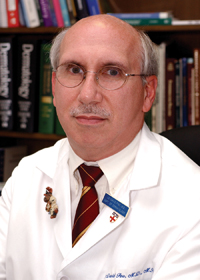
Jo-David Fine, M.D.
Rare genetic skin disease experts gather in Nashville
Epidermolysis Bullosa (EB) is a rare genetic disease that has an often devastating impact on those who have it and their families.
The Dystrophic Epidermolysis Bullosa Research Association (DebRA) of America is holding its biannual Patient Care Conference in Nashville June 1-4, with one of the speakers being Jo-David Fine, M.D., professor of Medicine (Dermatology), who has made the study and treatment of EB his focus for more than two decades.
“This meeting is an ideal way of letting larger groups of patients meet some of the clinicians who treat or study this disease, as well as to network among themselves,” Fine said.
More than 200 people are registered to attend.
Fine came to VUMC two years ago and is working to re-open for enrollment a database of 3,300 EB patients, the largest in the world. The database is housed at the Monroe Carell Jr. Children's Hospital at Vanderbilt.
Fine said the database, which was originally created in 1986 under NIH funding, will be available, under guidelines approved by the Institutional Review Board, to researchers on any aspect of this disease.
“The end result of research that is currently being pursued worldwide on possible gene therapy for this disease undoubtedly will be applicable to other more common genetic diseases,” he said.
EB is usually evident shortly after birth. Fine describes EB as “essentially an inherited second degree burn which may involve the entire skin surface area, as well as potentially any other organ lined or covered by epithelium.”
Even the scant pressure of clothing or a routine passing brush against another person or object can lead to painful blisters. In order to protect the skin from infection after blisters burst, patients must often have head-to-toe dressings, which must be changed once or twice daily.
There is no specific treatment for the disease; at present clinicians work to anticipate and intervene on complications.
The best estimates of prevalence and incidence of EB in the United States population, based on data collected by the National EB Registry, are about 8 in 1 million and 19 in 1 million live births, respectively.
Beyond the oftentimes devastating medical aspects of EB, families dealing with a sick child often have serious financial, social and psychological issues.
“The lives of parents of affected children almost exclusively revolve around their day to day wound care,” Fine said. “As a result of the amount of time and cost of such daily care, these families often can't afford to pursue many family activities which we take for granted, including eating out, taking vacations or providing for non-essential care or education of their unaffected children.”
During the Nashville meeting, Fine will deliver a lecture titled “Understanding EB,” as well as supplement other speakers with registry data on specific extracutaneous complications. Other lectures will cover all aspects of caring for EB patients.
“One of the most valuable aspects of this biannual conference is to provide a forum whereby parents who have just had a baby with EB can meet and network with other parents who've already learned a great deal about how to care for these children and to cope with the impact of such a disease on their families and communities,” Fine said.













